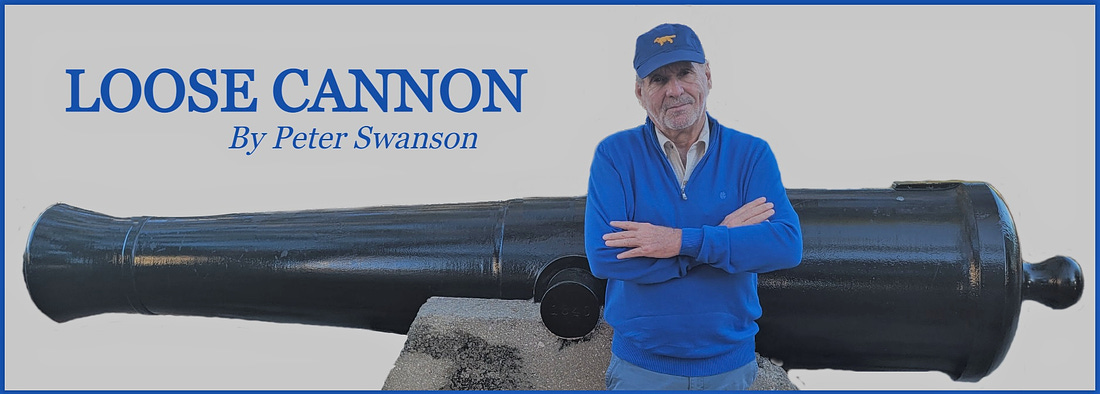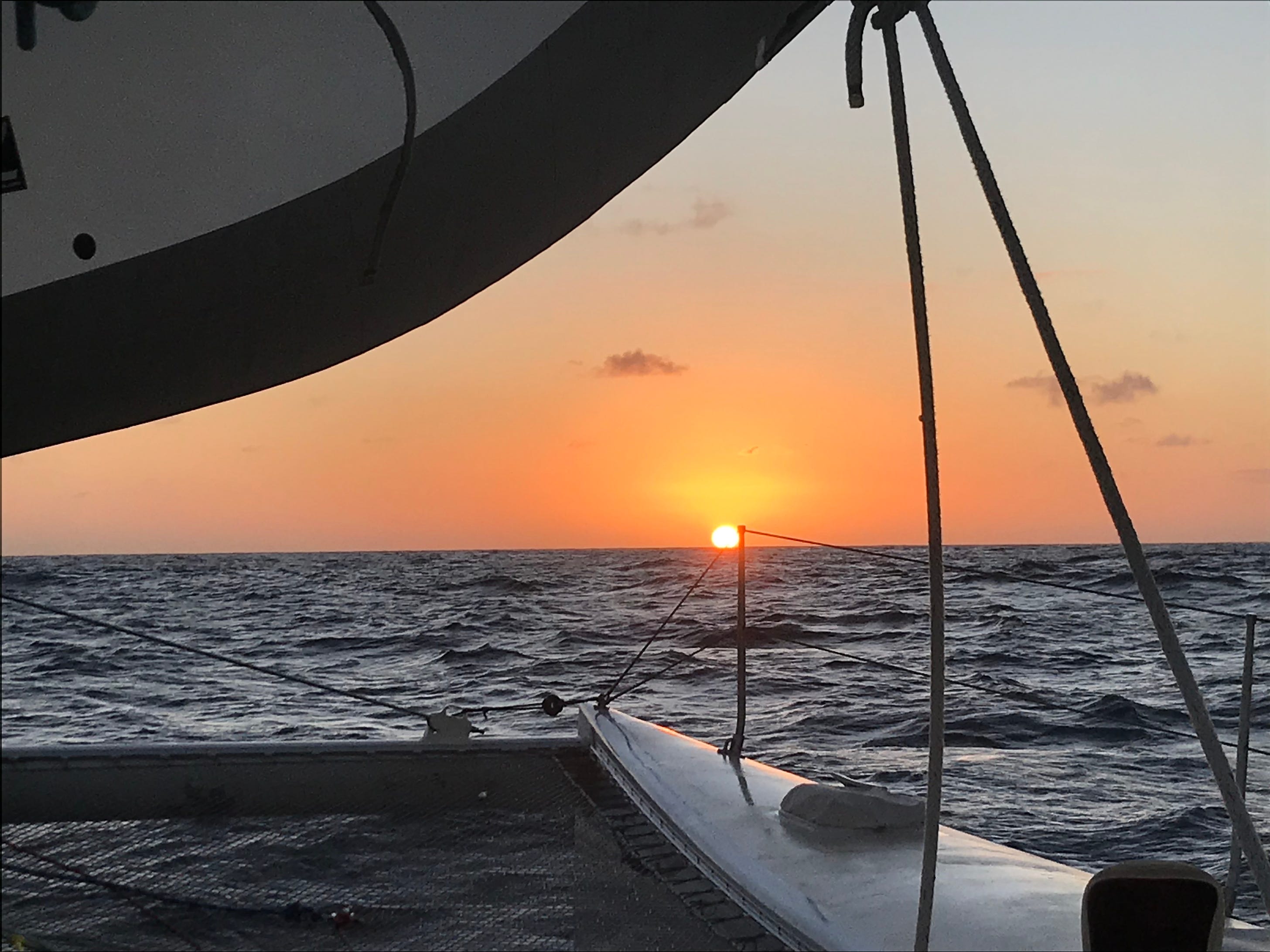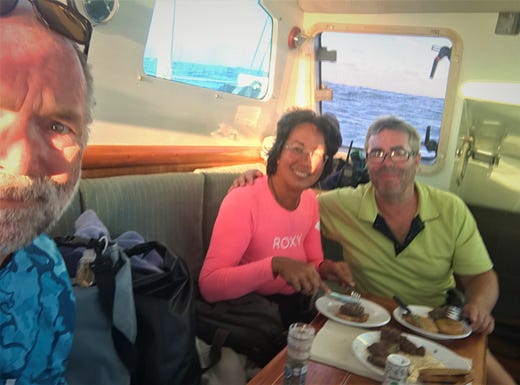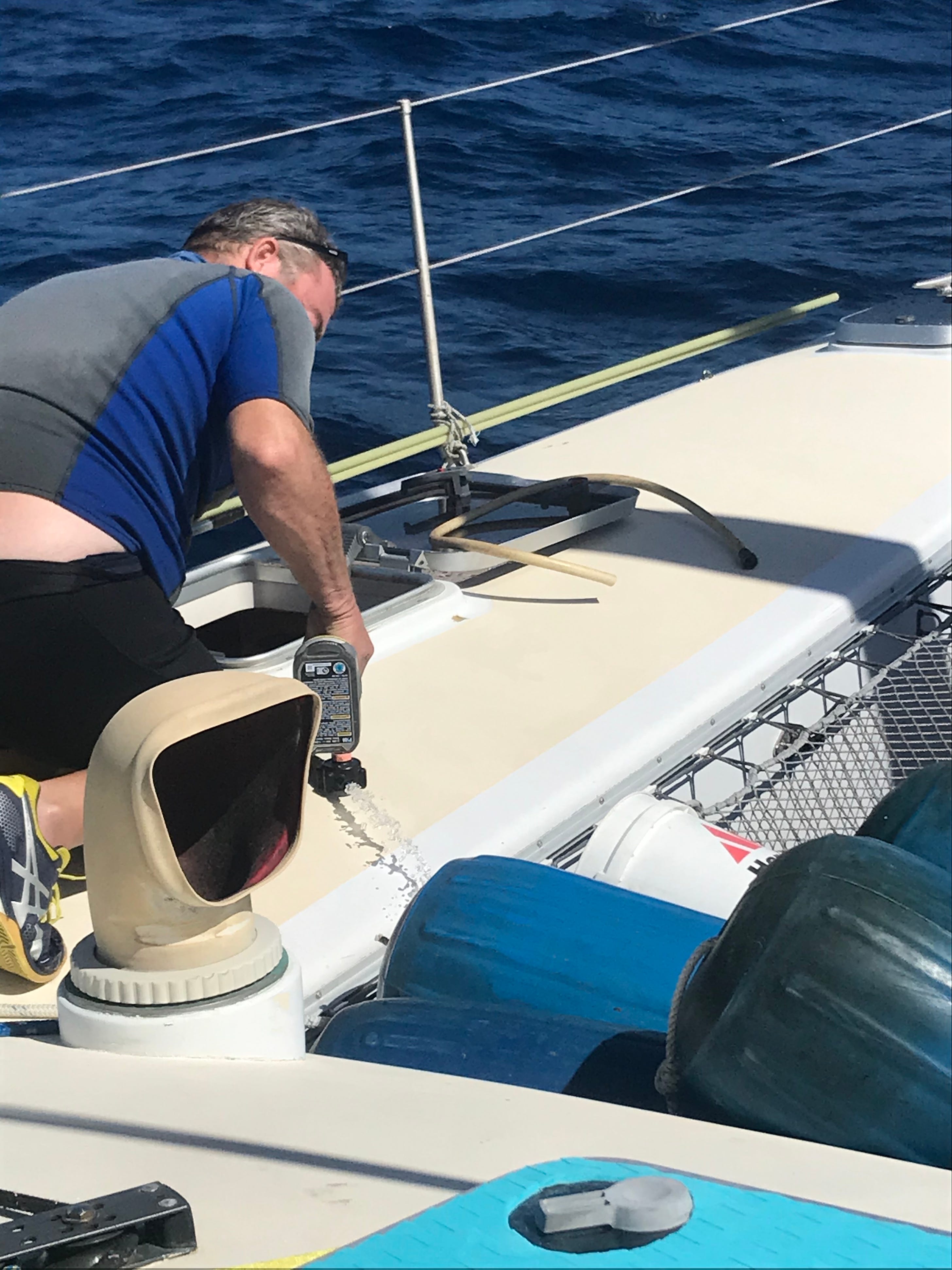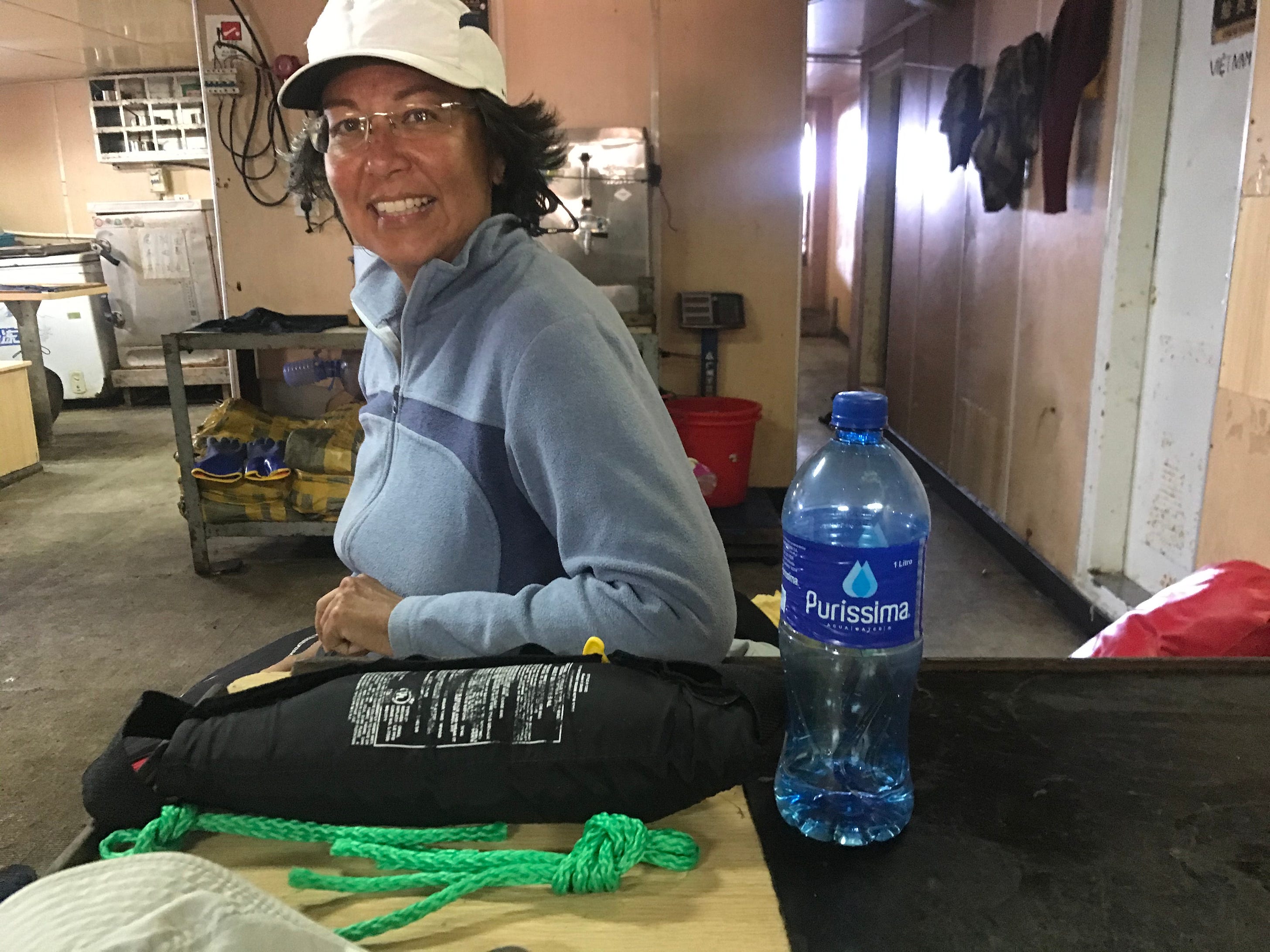When all else fails, try journalism.
'Struck by Whale. Taking on Water'
Catamaran Crew Rescued Twice After Distaster 'In the Heart of the Sea' (Gallery)
The last night aboard One Tree Island before disaster. (Photo by Peter Nielsen)
By Peter Nielsen
It’s noon on Sunday, August 23, 2020, just another day in the life of a small crew sailing across the Pacific. The Atlantic 46 catamaran One Tree Island is making a steady 6-7 knots below an electric blue sky, heading south-southwest under a reefed mainsail and genoa, both well eased in the 12-knot southeasterly breeze; less sail than we’d like to carry, but we’ve learned to tailor boatspeed to sea state, and the two-meter swells topped by frequent smaller whitecaps make for an uncomfortably bumpy ride if we push harder. Panama is 2,500 miles astern, we’ve been at sea for 18 days, and if we keep to even this modest speed we’ll be cracking the champagne in the Marquesas, 1,500 miles away, in less than ten days.
Shoals of flying fish erupt startled from the water around us and scatter among the waves, fleeing the strange beast looming above them. Querulous moans from the Simrad hydraulic autopilot’s motor provide a vocal counterpoint to the rhythm of the water rushing along the slender hulls. Not for the first time, I think of how the autopilot sounds sometimes like whalesong, other times like distant voices raised in complaint. I’ve been sleeping right next to that hardworking motor for weeks, both cursing it and blessing it.
Willy Stephens, skipper and owner, is asleep in his bunk in the port hull, a couple of feet from my perch in OTI’s forward cockpit. I’m hoping he wakes up before too long to bake another loaf of his rather good bread. His wife, Anne, who I relieved on watch a few hours ago, is belowdecks, foraging for a book.
Me, I’m mentally planning next year’s cruise from Florida to the Bahamas and onward, reading a page of Bruce van Sant’s “Passages South” between each lingering look around the horizon. Not that there is ever anything to see; we haven’t had an AIS target in days, and apart from the flying fish and small squid that commit hara-kiri on the tramp and decks every night, only a few small black-and-white seabirds enliven our watches. There is only ever the sea, huge and indifferent, and the horizon, which we chase to no avail.
We are late travellers in the Pacific; the prime season for the Panama-French Polynesia crossing is from February to April, according to the ship’s bible, Jimmy Cornell’s “World Cruising Routes.” Any later, and you don’t get to spend much time in these legendary islands before heading for cyclone-season shelter in New Zealand or Australia. In this year of Covid, though, there is no normality. That we are even here is entirely due to the microbe.
Long story short, expat Brits-turned-Kiwis Willy and Anne had planned to cross the Atlantic from the United States in May with their just-launched, totally refitted cat, but as borders began to slam shut after Covid took hold in March, it became obvious that their options were becoming more limited by the week. They were stuck in a Florida boatyard, reading ever-sadder accounts of cruisers stuck in sailing limbo around the world, too frightened to leave one country in case they weren’t allowed into the next.
With their American visas about to run out, Willy and Anne tore up their cruising plans and decided to gamble on a nearly-straight run to New Zealand, which had shut down sooner than almost any other country and was only letting in citizens and residents. The Panama Canal was open, though they’d first have to spend two weeks in quarantine; furthermore, it appeared that they would be able to stop in French Polynesia, their weeks at sea being sufficient proof that they weren’t carrying Covid to the islands.
Where do I come in? I was refitting my own boat in the same yard, but had lost my impetus when it became apparent my cruising plans for 2020 would have to go on indefinite hold. Being possessed of that most desirable of things for a 2020 transPacific sailor, a New Zealand passport, I gladly came aboard as the third hand, thus fulfilling both insurance and nationality requirements.
On this August day we are just over three months into the journey. We’ve motored down the Intracoastal Waterway in Florida from Jacksonville to Fort Pierce, then sailed above and around the Bahamas, through the Windward Passage between Haiti and Cuba, and across a lumpy and surly Caribbean Sea. We sweated out our two-week sentence in Covid jail anchored in the tropical heat outside Panama’s Shelter Bay marina, sat in the marina in air-conditioned comfort for another two weeks, and then, just to round things off, spent another two weeks at anchor outside Panama City after passing through the Canal, waiting on a new staysail and having deck awnings made.
Such delays are the stuff of cruising, though, and having listened to some sad tales we know we are better off than many sailors. At least we know we’ll be welcome in New Zealand for the cyclone season.
Peter Nielsen and Anne and Will Stephens enjoy a meal aboard One Tree Island after colliding with a whale. They were not going to waste steak. (Photo by Peter Nielsen)
As I turn towards the bow, I register out of the corner of my eye a dark shape in the water just ahead of us. A nanosecond later, at the instant I recognize it as a whale, the port bow makes contact with it and the boat jolts as if bashing into a steep head sea. I have just enough time to shout “####! Whale!” at the top of my voice before the big beast passes down the port side, and as it does so I feel and hear a crunching impact.
Willy shoots out of his bunk, instantly awake, and the three of us stare out the rear portlights at the whale lying on the surface in a froth of pink-tinged foam. For a moment we are all transfixed. Then I see a red warning light on the switch panel and say “bilge, mate, check the bilge!” and we snap out of it.
Willy jumps down the steps into water that’s already ankle-deep, gushing into the boat from the hanging locker outboard on the port side. Tearing out its contents, he sees bright blue sea through a pair of inch-wide vertical cracks in the cedar-strip-and-glass hull, water spurting into the air. Grabbing a couple of T- shirts, he stuffs them into the cracks, then disappears into the aft locker and emerges with two of those proprietary orange foam rubber cones that are supposed to plug leaks – just not our kind of leaks, as he quickly finds. The T shirts will have to do for now. Meanwhile Anne is in the cockpit, cranking away at the manual bilge pump, and I pull down the mainsail and roll away the genoa.
With the leak slowed if not staunched, it becomes obvious that we are in no immediate danger of sinking. When Willy replaced the engines he also sealed their compartments, so there is at least some reserve buoyancy in the hulls. There are no watertight bulkheads forward, though, but Willy has an idea. At this point the entire forepeak is still well above water and its door has a high threshold. He grabs a roll of stickyback rubberized tape and applies it all around the door, effectively sealing it, moments before the rising water would have slopped over the sill.
“Right,” he says. “Let’s have a look at the damage. Maybe we can patch it from the outside.” I tie a safety line around his wrist and he goes over the side. “There’s a big dent maybe 3 feet across, with two cracks in it, just above the keel,” he reports. Ouch. That’s possibly the worst place for it. There’s no way we can fother it with a sailcloth patch, and nothing will stick to the slime-coated ablative antifouling. There’s a real danger of being struck by the hull as it lifts and falls in the swells. Nope.
By now the water is chest-deep in the port hull, but it seems to have reached its natural level just a few inches below the bridgedeck. The hull cracks are now well out of reach from the inside, not that we can plug them effectively. At this point we have not sent out a distress signal, but Willy has set Anne to the task of letting Frank, their shore side contact in New Zealand, know what is happening via the Iridium Go email. Now Willy and I talk out the situation.
Will Stephens tries to dewater the port hull. (Photo by Peter Nielsen)
Are we in danger of sinking? Not immediately. Catamarans are hard to sink, and this one is especially so, by virtue of its wood and foam construction.
What would make the situation worse? If the wind increases and the sea state gets up, there’s a good chance that water will slop over into the starboard hull – which is still dry – and sink us lower in the water. Waves will break over the boat, and then we’ll be more than just uncomfortable. Predictwind has the wind increasing to 20 knots in couple of days.
Do we want to abandon the boat? No, but it seems we have no option. The liferaft, though, will be the very last resort.
Already we are taking some hefty slams from waves surging under the hull and smashing against the bridgedeck, and the decision is made. Willy activates the EPIRB, and just for the hell of it I hit the emergency button on my SPOT X satellite communicator, tapping out a short message: STRUCK BY WHALE. TAKING ON WATER. Just over half an hour later, Will gets an email from the Joint Rescue Coordination Center in Honolulu, Hawaii, asking us to confirm the EPIRB signal. From then on, events develop in a slightly surreal fashion. The JRCC brings the Peruvian Coast Guard into the picture; just last year the U.S. and Peru signed a joint SAR agreement to work together in the Eastern Pacific, and we are soon handed over to an enthusuastic Peruvian Coast Guard officer, who tells Will that a Chinese fishing boat some 24 miles away has agreed to take us on board.
He and Willy enter into a series of changes by phone, where a combination of poor reception and the language barrier make for some entertainment through the afternoon. The Chinese captain does not speak English, none of us speak Spanish, and out Peruvian friend’s English is heavily accented.
It seems the Chinese longliner is engaged in fishing and won’t be with us until after dark, some six hours from now, which gives us plenty of time to pack a change of clothes and some personal effects to take with us. These emergency supplies also include the contents of the freezer and the spirit and wine lockers, and all the chocolate and candy bars on board. We doubt there’ll be much of that on a Chinese longliner. There’s a large piece of rather good steak in the fridge that we don’t want to leave to Neptune, so we cook that up for our last lunch. That done, there is nothing to do but wait.
Meanwhile, Frank has set the New Zealand support system in motion and is letting friends and relatives know that we’re in no immediate danger. He’s contacted the Tahiti and Honolulu JRCCs, along with the Rescue Coordination Center in NZ and the Centro de Control de Misiones del Peru, and is keeping us updated as news develops.
As night falls, a bright light astern signals the arrival of the Fu Yuan Yu. We each fire a red flare—just to say we’ve done it in anger. We’ve got every light on board going so there’s no way she can miss us. As the small ship draws close to windward the excited shouts of her crew drown out the throb of her diesel. In a surreal moment that is typical of the times, the crewmen lined up along the rail are all wearing masks, here in the literal middle of nowhere.
She stops and drifts down on us, and the two vessels meet with a crunch. Her fish gate is only a couple of feet above our deck. Willing hands snatch the bags we pass up and then one by one, timing the rolls, we are plucked off One Tree Island.
Then half a dozen crew swarm onto OTI. Two head for the dinghy and outboard, which are hoisted aboard in short order. Others disappear belowdeck, emerging laden with odd items of gear. Pillow and blankets come flying up to the deck, where we sit taking all this in. There is shouting, a lot of it. A pile of books is thrown aboard one by one. Towels, suncare stuff, charts, odd items of clothing, boxes of stainless steel fasteners, Willy’s drone, assorted shoes, even my treasured travel umbrella, make their way onto a growing pile of gear.
Then one of the crew turns to us and spreads his arms enquiringly. “Santamaria?” he asks. I have no idea what this means but nod my head, and then there is a final flurry on OTI as the crew carries up more tools, handheld VHFs, binoculars and the like, all of which disappear up to the bridge. Meanwhile the swell is increasing and the two vessels roll and grind against one another. I see and hear the stanchions ripped loose and feel the crunching as the Fu Yuan Yu’s steel gunwale crushes OTI’s hull-deck joint. One of the crew trips and almost falls between the boats as he scrambles back aboard. Then there is more loud shouting and suddenly OTI is drifting astern, her lights still ablaze.
I look at my watch. It is 21:30, just nine hours since we hit what we later agree is a half-grown sperm whale and eight hours since we triggered the EPIRB. In this part of the ocean, it must be a record for a rescue. The transition from flooded sailing boat to noisy, brightly lit fishing boat is surreal. The din from the engine is overpowering, and there seems to be people everywhere, all trying to help us in one way or another. We are ushered into a tiny cabin, just 10-by-7 foot, with four bunks in it. Somehow we fit all our possessions in there and we understand why the crew salvaged our blankets and pillows – there were no spares on this boat. In fact there are not even mattresses—the crew sleep on half-inch-thick futons. An AC unit on the bulkhead keeps the temperature manageable, fortunately—and it’s a hell of a lot more comfortable than a liferaft.
Anne Stephens aboard the Fu Yuan Yu. (Photo by Peter Nielsen)
The sharks’ fins, great delicacies in China, are cut off, bagged and snap-frozen; their owners are weighed and then join their fins in the freezers. Much of the bycatch goes to the galley, as the staple diet on the ship is rice and fish. The captain, obviously aware of the political sensitivity surrounding longlining, indicates that he’ll confiscate our electronics if he sees us taking photographs. He even gets angry when he sees me writing in my notebook.
Meanwhile, Willy is in contact with the Peruvian Coast Guard, who have been phoning the captain at odd hours. Each time, a crewman is dispatched to fetch Willy up to the captain’s cabin, where he is forced to drink beer and smoke cigarettes with our host while they communicate via the time-honoured method of sign language and raised voices, in between talking to the ship’s owners and the Peruvians.
The problem is finding a way back to land for us, given that the captain is as keen to get us off as we are to leave. The Fu Yuan Yu has been fishing nonstop since October 2019, and won’t be back in port for another six months. Our only hope of getting off her seems to be on one of the tankers from Panama or Peru that periodically resupply the 250-odd Chinese fishing boats in the eastern Pacific. This may not happen for a few weeks, a dire prospect; I for one would never be able to look at fish or rice again. The thought of Peru is positively uplifting.
However, back in New Zealand, Frank has been tirelessly working behind the scenes on our behalf. He has found and contacted the agents for ships coming through Panama and heading west past our general location, which is on the rhumb line to Tahiti. On our second day on the Fu Yuan Yu, he has good news for us; the captain of the Wallenius Wilhelmsen line’s MV Tonsberg, a RORO ship bound for—hurrah!—Auckland, has agreed to stop by and rescue us from our rescuers. It will catch up with us on the morning of the 27th. The interaction between Willy and the Chinese escalates, with the ship owners helping to translate. Finally, much beer and smoke later, there is consensus: the captain agrees to meet the Tonsberg at a specified position, the end point of one of its longlines. Once all the line is on board, we will be transferred via the Tonsberg’s rescue boat.
In the meantime, we slip into the routine of the Fu Yuan Yu. We join the crew at mealtimes, eating our rice and fish sitting at the officers’ table with the chief cook and engineer. The cook is friendly and smiling, the engineer not so much, until Willy gifts him all the tools that were taken off OTI. The mate is animated and talkative, sparing no effort to make us understand. Officers excepted, the crew isn’t made up exclusively of Chinese nationals; the young deck hands are from Indonesia, Vietnam and the Philippines. Some speak a little English, and Anne, who is Malaysian by birth, speaks some Indonesian. They tell us they were hired on two-year contracts, and haven’t touched land since the previous October. They fish around the clock, every single day; the only break comes when the mother ship arrives to take off the catch and resupply them with bait and provisions. It’s a hard life, with nothing in the way of creature comforts. Dangerous, too; the ship rolls enough in calm weather and I wouldn’t want to be on the fish deck in a blow.
The crew and officers are kind, constantly pressing small gifts on us; cartons of cigarettes—everyone on board seems to smoke incessantly—sweetened instant coffee, boxes of noodles. When the time comes for us to leave, we try to repay these small acts of kindness by dividing our bedding and pillows and spare clothing between them, along with a few bottles of wine and rum.
Loose Cannon features great guest authors and their sea stories. Subscribe for free to receive new posts.
Subscribe now
There’s high excitement among the crew when the Tonsberg finally comes into view, a huge red and white presence blocking the horizon. Considering that apart from the Fu Yuan Yu we haven’t seen another ship in over three weeks, I don’t blame them. There’s a big swell running, and we are relieved to see the Tonsberg’s rescue boat is considerably larger than the RIB I’d been expecting. Steered by the ship’s Chief Officer, Boris Ribicic, it gingerly comes alongside, its bow rising and falling a metre or more with the swells while Ribicic expertly steers away when the ship’s threatening steel rubbing strake rolls towards him. This is where things can go badly wrong, but no, these guys know what they’re doing—the bags go in first, then us, one at a time, judging the roll and the distance and helped by the longliner crew, and the boat reverses away and we are off, bouncing across the steep seas.
The Tonsberg’s clifflike topsides stretch 30 metres above the water, a rope ladder dangling down and meeting a partly lowered gangway halfway up. I am thinking of the Australian couple who, a few weeks before, had been lost while trying to board a freighter from a liferaft, but in the Tonsberg’s lee the sea is flat and the three of us scale the ladder one at a time. Soon we are being welcomed by the ship’s officers in what seems to us like the lobby of a city hotel, then shown to large, comfortable cabins.
Later that night, over a beer with Captain Josip, Boris and Chief Engineer Niksa Surkovic, we relive the events of the past four days. Ours had been possibly the softest abandon-ship scenario I could have imagined; if I needed another reminder, I only had to look at OTI’s undeployed liferaft, which now had pride of place in Willy’s cabin. Almost exactly two weeks later, we dock in Auckland, where after two nights in quarantine we are released into the general population. We’ll never forget the kindness of the Fu Yuan Yu’s crew, who obeyed the law of the sea to help fellow mariners in distress, nor that of the Wallenius Wilhelmsen line and the crew of the Tonsberg, who were under no obligation to help us, since we’d already been rescued. Twice in one week—that’s a record I hope never to break.
What We learned
- Communication is key. The ability to exchange information with rescuers can save your life, or at least make a nasty situation more bearable. Take a satphone, a device like our Iridium Go, a Garmin InReach or SPOT X, and watertight bags or cases for your phone or tablet.
- Don’t panic. We had not talked though what we’d do in the case of such an emergency, but Willy and I had both been through the scenarios in our minds many times over our years of sailing. We went through the stages one by one—identify and try to stop the leak, send the emergency signals once we were sure the boat could not be saved, communicate with the authorities, add other equipment and supplies to the grab bag we had already packed. We were lucky in that the boat as not about to sink. Had One Tree Island been a monohull, I am sure we’d have been in the liferaft within an hour.
- Further to the previous point, expect the unexpected. Although we did not expect to hit a whale—after all, who does that?—we were aware it could happen. The hardest thing to defend against on a small boat is hitting something you cannot see. As to keeping watch, you won’t see objects that are just awash until you are literally on top of them.
Could We Have Saved the Boat?
Here’s what the skipper said:Of all the safety gear, tools and spares on board, I had nothing to plug a hull breach of this size and shape (two narrow 8-inch cracks, perhaps an inch wide at the middles). I had three or four JB Weld epoxy putty sticks, I needed ten or twenty times more! I was so frustrated.
That is my take away from this. So frustrating that I had nothing to work with, no solution to plug a simple, fully accessible hull breach! The only recommended item for pluging a leak below the water line is a soft wood bung! Might as well be a chocolate tea pot. What I needed was an epoxy dough ball—a six-pack of cricket ball sized epoxy putty balls. Knead for two minutes, stuff it into or over the hole (even underwater), hold for five mins while curing, repeat until the hole or leak is plugged—SIMPLE! Why is no such thing on the market? If it is, why isn't it recommended or mandated along with soft wood bungs and flares? It is my hope that this question is picked up and that the leisure marine industry is encouraged and incentivised to market a solution. |









 Reply With Quote
Reply With Quote